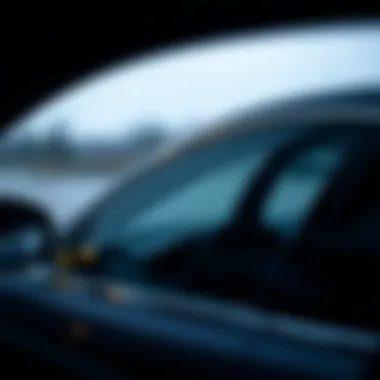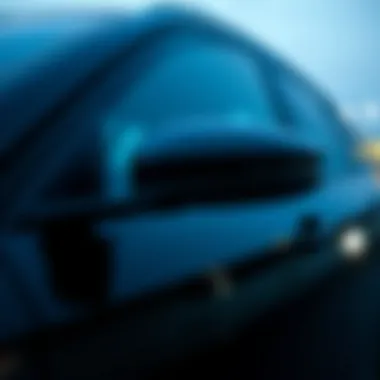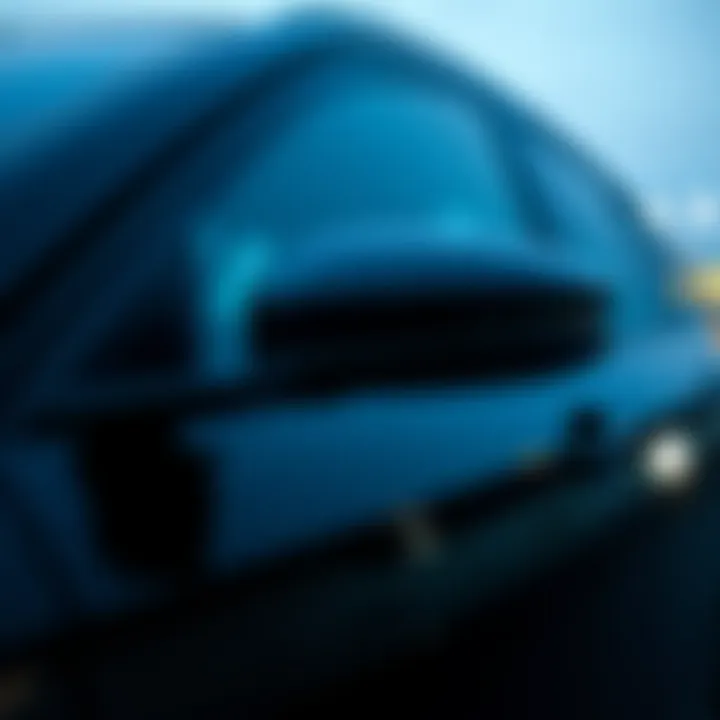Replacing Rubber Seals Around Car Windows: A Guide


Intro
Maintaining a vehicle often feels like a never-ending chore list for car enthusiasts and everyday drivers alike. Among the myriad of tasks that ensure a vehicle runs smoothly, replacing the rubber seals around car windows is one that many overlook, yet it plays a critical role in preserving the vehicle's integrity and comfort. If you've ever experienced a draft or noticed water leaks after a rainstorm, the culprits may very well be your window seals.
Considering that these rubber seals act as a barrier to dust, moisture, and noise, neglecting them can lead to a range of issues from rust formation to unpleasant cabin noise. It's not just about aesthetics; it's about ensuring that every ride is as pleasant as possible. This guide is crafted to take you through the nuts and bolts of ensuring both your vehicles and boats have sound seals around their glass.
We'll provide you with:
- Insights into the types of rubber commonly used for window seals and their specific qualities.
- Telling signs that suggest a need for immediate replacement, ensuring your vehicle's longevity.
- A step-by-step process to accomplish this task with confidence and skill.
- Tools you'll require, along with tips to avoid common mistakes.
By the end of this guide, you’ll not only understand why these seals are paramount for your car’s health, but you’ll also be equipped to take matters into your own hands, transforming what could be a daunting task into a straightforward process.
Understanding the Importance of Window Rubber Replacement
Rubber seals around car windows may not always be top of mind, but their role in maintaining the overall functionality and appearance of your vehicle can't be overstated. These unsung heroes of automotive design serve purposes that extend well beyond mere aesthetics. Whether you’re an automotive enthusiast or a regular driver, understanding the significance of these seals is crucial for ensuring your vehicle operates at peak performance.
Role of Rubber Seals in Vehicle Functionality
Rubber seals are the frontline warriors against water, dust, and air leaks. They effectively insulate the interior of your car from external elements. Think of it like a well-sealed thermos; if the seal is compromised, the entire system becomes less effective. Worn or damaged seals can lead to an array of issues, including water leaking into the cabin and causing mold or rust. This, in turn, may affect electronic components that reside within the vehicle. Kind of like throwing a wrench in the gears, isn't it?
Moreover, proper rubber seals enhance the aerodynamics of your vehicle. When the seals are intact, airflow over the car body is smoother, leading to better fuel efficiency. Rubber seals are not merely sacrificial components; they maintain structural integrity and optimize overall vehicle performance. Hence, replacing worn or damaged seals is not just an aesthetic choice—it's essential for seamless driving experience.
Impact on Vehicle Aesthetics and Value
Apart from functionality, the condition of your car’s rubber seals can significantly impact its visual appeal. Damaged or worn-out seals can create gaps that are unsightly and distracting, affecting how others perceive your vehicle. It’s the difference between rolling in style and looking like a car that’s seen better days. A well-maintained car speaks volumes about the owner’s care, pride, and commitment to maintaining quality.
Furthermore, maintaining rubber seals is a prudent investment in your vehicle's resale value. A car that is free of leaks and aesthetic flaws not only attains higher offers but also attracts more discerning buyers. After all, who wants to part with their hard-earned cash for a vehicle that looks like it needs some serious TLC?
"Investing in the upkeep of your car is like planting a seed; the healthier you keep it, the richer the rewards."
To sum things up, the importance of window rubber replacement cannot be overlooked. It's essential for vehicle functionality while also enhancing appearance and preserving value. Whether you’re keeping your trusty ride for years to come or planning to sell it, finding the time to assess and replace worn-out seals can lead to better overall performance and lasting satisfaction.
Identifying Signs of Worn or Damaged Rubber
Recognizing when rubber seals around car windows need attention is crucial for maintaining both vehicle performance and appearance. These seals are often overlooked, yet they serve a vital role in keeping various elements at bay, such as water, dirt, and noise. By learning how to effectively identify wear and tear, car owners can prevent further complications down the line, saving themselves from potential costly repairs and ensuring that their vehicles remain in top shape for years to come.
Common Indicators of Deterioration
Several tell-tale signs indicate that car window rubber seals may have experienced deterioration. Paying attention to these indicators is not just about appearances; it’s about investing in the long-term health of your vehicle. Here are some common signs to watch out for:
- Cracks and Splits: One of the most apparent signs of wear is visible cracking or splitting in the rubber. These breaks may allow water to seep in, paving the way for rust or water damage.
- Discoloration: Fading color, especially if it turns a dull gray or brown, suggests that the rubber is losing its structural integrity due to exposure to UV rays and chemicals.
- Hardening or Softening: A rubber seal should maintain a certain level of flexibility. If you notice that the rubber has either become hard and brittle or too soft and pliable, this is an indication of a compromised seal.
- Lifted Edges: If the edges of the rubber seem lifted away from the glass or frame, it's a sign that the adhesive is failing, creating gaps that can lead to leaks.
- Drafts or Noise: Increased road noise or drafts while driving may suggest gaps in the seals, indicating that they are no longer performing their intended function.
Vigilance in identifying these signs can make a world of difference. Regular checks, especially after extreme weather conditions, can help you stay ahead of any deterioration.
Consequences of Ignoring Replacement Needs
Neglecting to address worn or damaged rubber seals can lead to a cascade of problems that might affect both the comfort and safety of your vehicle. The consequences can be more grim than just a minor inconvenience.
Ignoring the need for replacement can turn a small issue into a major dilemma!
- Water Damage: One of the immediate threats from failing rubber seals is water intrusion. Ripped or missing seals allow rainwater to enter the vehicle, which may lead to corrosion of metal parts, mold growth inside the car, and a generally unpleasant odor.
- Increased Noise: When rubber seals no longer fit snugly, outside noise becomes more pronounced. This can detract from the overall driving experience, making it more jarring to navigate city streets or highways.
- Reduced Energy Efficiency: Damaged seals can compromise the insulation of your vehicle, making heating and cooling systems work overtime. This can result in higher fuel consumption as your car struggles to maintain the desired temperature.
- Resale Value Impact: If you plan to sell your car at any time, poor maintenance of rubber seals can dramatically lower its value. Prospective buyers are likely to notice worn seals during their inspection, which might deter them from making a purchase.
- Safety Concerns: Lastly, damaged seals can obscure visibility or allow foreign elements to enter, leading to distractions while driving. In extreme cases, loss of visibility could lead to accidents.
In essence, keeping an eagle eye on those rubber seals will save you not just money but potentially some headaches too. Taking action sooner rather than later is not merely advisable; it’s essential for the longevity and functionality of your vehicle.
Types of Rubber Used in Automotive Applications
Rubber plays an integral role in maintaining the functionality and aesthetics of vehicles, especially around windows. Understanding the types of rubber used in automotive applications can make a world of difference when it comes to selecting the right replacement seals for your car. Different rubbers have unique properties and benefits, and this section explores these variations in detail.
Natural vs. Synthetic Rubber


Natural rubber, derived from the sap of rubber trees, has been a staple in the automotive industry for decades. Its elasticity and resilience make it an excellent choice for window seals, but it is not without its drawbacks. Natural rubber is susceptible to environmental factors - UV rays, ozone, and even extreme temperatures can lead to premature aging and deterioration.
On the flip side, synthetic rubber is engineered to overcome many of these limitations. Materials like EPDM (ethylene propylene diene monomer) and butyl rubber boast exceptional resistance to weathering, making them ideal for external applications like window seals. They don’t just resist UV and ozone; they also maintain their flexibility over a remarkably wide temperature range. Choosing the right type often comes down to the environment in which the vehicle operates. For harsher climates, synthetic rubber might just be the better bet.
"Choosing the right rubber for automotive applications can define not just the longevity of your vehicle’s components, but also its overall performance and reliability."
Comparative Longevity and Performance
When it comes to longevity, synthetic rubber typically outshines natural rubber. Data indicates that while natural rubber may last, on average, around five to seven years under standard conditions, synthetic options like EPDM can last up to fifteen years or more. This durability translates to fewer replacements needed, lowering the cost in the long run.
Performance-wise, synthetic rubber tends to outperform natural rubber in a variety of conditions. Its superior resistance to low and high temperatures, as well as chemicals that might otherwise cause degradation, offers vehicle owners peace of mind. On the other hand, natural rubber does offer better initial grip and comfort, which can enhance driving experience but may come at the cost of durability.
If you’re in the process of deciding between these options, it’s worth considering how often you face extreme weather, as well as your driving habits. A person who frequently navigates in rainy conditions, for instance, might find better satisfaction with synthetic rubber’s waterproof qualities.
In summary, knowing the differences between natural and synthetic rubber, alongside their longevity and performance characteristics, is essential when replacing window rubber. This knowledge can pave the way for informed decisions that enhance both the durability and functionality of your vehicle's seals.
Tools Needed for the Replacement Process
Replacing rubber around car windows is a task that can greatly influence both the appearance and functionality of your vehicle. But before diving into the replacement procedure, it's crucial to gather the right tools. These ensure that the job is done efficiently and effectively, minimizing mistakes and rework. A well-equipped toolkit not only aids in a smoother process but also saves time and potentially costly damage to your vehicle.
Essential Tools for Window Rubber Replacement
Before you kick off the replacement, here are some essential tools that you'll need to have on standby:
- Utility Knife: A sharp utility knife is necessary for cutting the old rubber. Its precision is crucial to ensure clean edges.
- Plastic Scraper: This helps in removing old adhesive residues and ensures that the surface is prepped correctly without damaging the underlying material.
- Replacement Rubber Seals: It sounds obvious, but make sure to purchase seals that are specifically designed for your car model to ensure a snug fit.
- Adhesive: Depending on your vehicle, you may need specific adhesives. Butyl tape or automotive sealant can work well; they provide excellent water resistance.
- Rags or Paper Towels: Keeping your work area clean is always a good practice. They'll come in handy for cleanup during and after the installation.
- Safety Glasses: Protect your eyes from any debris while working.
- Hand Gloves: To avoid any contact injuries or irritating skin, gloves are beneficial, particularly when handling adhesive or rubber compounds.
- Measuring Tape: Precision is key. You want to ensure your new seals are cut to the correct length before installation.
In gathering these tools, you're setting yourself up for success by reducing the risk of interruptions and enhancing the overall quality of the replacement job.
Safety Gear Considerations
While focusing on the technical aspects, one mustn't overlook personal safety. The replacement process can involve sharp tools and chemicals that require caution. Here are some considerations for your safety gear:
- Gloves: Opt for chemical-resistant gloves, especially if you're using strong adhesives. If the rubber is old or degraded, it might have rough edges, increasing the risk of cuts.
- Protective Eyewear: Sturdy safety glasses will protect against anything that might fly up when you’re scraping or cutting.
- Face Mask: If you are sensitive to dust or fumes, wearing a mask can reduce inhalation of harmful particles, especially when removing old rubber and adhesive materials.
- Knee Pads: Installing rubber seals often involves kneeling. Protect your knees from discomfort and potential injury during the process.
Using proper safety gear not only ensures your well-being but also allows you to focus on the task at hand, knowing that you are protected from unnecessary hazards. Be smart, gear up, and get ready to give your car a touch of care!
Step-by-Step Guide to Replacing Window Rubber
Replacing window rubber is a vital maintenance task that can greatly affect both the functionality and appearance of your vehicle. When you embark on this process, you not only ensure the longevity of your car's seals but also safeguard it against external elements. Having a clear step-by-step approach equips you with the know-how to tackle the project effectively, making it manageable even for the less experienced hands among us.
Preparation and Initial Assessment
Before diving into the nuts and bolts, it’s crucial to gather all necessary materials and tools. This stage sets the foundation for the entire process. Start by assessing the current state of your rubber seals. Look for cracks, signs of wear, or areas where water seems to seep through. Taking the time to inspect can help you determine how extensive the replacement needs to be.
Checklist for Preparation:
- Inspect existing rubber for damage
- Clean the window edges and areas where rubber will be replaced
- Gather tools such as a razor blade, adhesive, and a putty knife
Doing this thorough prep work helps in identifying the right replacement materials, ensuring that they fit perfectly when you reach the installation stage.
Removing Old Rubber Seals
Once the assessment is complete, you can move on to removing the old seals. This step can sometimes feel tedious, but it’s essential for a smooth installation of new rubber seals. Start at one corner of the window, using a utility knife to carefully cut through the adhesive that holds the rubber in place.
Key Tips for Removal:
- Work slowly to avoid damaging the window or surrounding paint
- Use a putty knife to gently pry the rubber away from the surface
- Keep the old rubber handy as a reference for matching the new seals
If some adhesive remains stuck to the window frame after the rubber is removed, don’t fret; you can clean this up with appropriate solvents or a little elbow grease.


Installing New Rubber Seals
Now comes the part where you see fresh rubber in action. Before you start, ensure the new seals are the correct fit for your windows. Place the rubber in position and press firmly. A great idea is to apply a small line of adhesive to the area where the rubber meets the window frame for extra hold. Make sure you follow the manufacturer’s instructions regarding installation, as different types of rubber can have varying requirements.
Steps during Installation:
- Start at a corner and work your way around the window
- Ensure it sits evenly and securely without twists or bubbles
- Press down firmly to create a proper seal
Taking your time during this phase ensures that your new seals will perform well, extending their lifespan significantly.
Final Adjustments and Quality Checks
With the new rubber installed, it’s time to step back and have a look. Quality checks might seem like an afterthought, but they can save you from future headaches. Press on the new seals gently to ensure they are well-adjusted.
Final Checks to Conduct:
- Inspect for gaps or uneven surfaces
- Make sure everything aligns properly with window operation
- Finally, check for a watertight seal by spraying water gently on the edges
If everything looks good, you can call this job done and take pride in knowing you’ve contributed to the maintenance of your vehicle.
Remember, regular maintenance is key to a hassle-free driving experience. Having efficient window seals can lead to a quieter ride and lower risk of water damage, making it worth every bit of effort.
Common Mistakes and How to Avoid Them
In the endeavor of replacing rubber seals around car windows, one can easily trip over a few common missteps. For many, the process seems straightforward. Yet, amidst the excitement or perhaps the inconvenience, one can overlook key factors that could lead to future complications. Here, we will break down some of these pitfalls, enabling you to navigate the waters of rubber seal replacement smoothly and effectively.
Issues with Improper Installation
Improper installation can be more than just an annoyance; it may yield serious repercussions. When rubber seals are not fitted correctly, they can leave gaps. These gaps can allow water, dust, and air to infiltrate, which could impact your vehicle’s interior environment. You wouldn’t want your car to smell like wet dog, would you?
To steer clear of these troubles, it’s crucial to ensure that the seals fit snugly in their respective grooves. Take time during the installation process. The following pointers may help you:
- Read the Instructions: Always refer to the manufacturer’s instructions. It's like having a map on a road trip. Without it, you might get lost or, worse, end up in the wrong neighborhood.
- Use the Right Tools: Having the proper tools allows for a smoother installation process. For instance, using a flathead screwdriver instead of a specialized seal installation tool could damage the rubber or the vehicle.
- Check the Fit Before Finalizing: Before sealing it all up, ensure that everything aligns just right. Adjustments are easier at this stage than attempting a fix once it’s already set in.
By taking steps to ensure proper installation, you significantly reduce the risk of future leaks or damage.
Overlooking Alignment and Fit
Another common error is overlooking alignment and fit during the seal replacement process. Think of rubber seals as the outer defense of your vehicle. If they aren’t perfectly aligned, it’s like putting a screen door on a submarine. Water and air can seep through, undermining a vehicle’s integrity.
Proper alignment guarantees that the rubber seals sit flush against the window frame and the body of the vehicle. A misaligned seal not only compromises performance but can lead to further damage over time. Here’s how to avoid this mistake:
- Take Measurements: Use a measuring tape to ensure that the seals are evenly placed around all sides. This practice might sound tedious, but it’s like checking your homework before handing it in – a small investment of time can save you a headache later.
- Do a Visual Inspection: Stand back and look at it from different angles. Sometimes all it takes is one glance from the right perspective to spot an issue.
- Test the Fit by Closing the Window: Before securing the seals completely, close the windows and see how they react. If the seals are obstructing the window or if you feel resistance, it’s time to adjust.
Getting alignment right may take a few tries, but the peace of mind that comes with knowing your vehicle is protected is well worth the effort.
Proper installation and alignment of rubber seals are essential not just for functionality, but also for the longevity of your vehicle. Mistakes here can lead to costly repairs down the road.
By steering clear of improper installation and alignment issues, you position yourself to succeed in your project, ensuring your vehicle's windows serve their purpose effectively and efficiently.
Maintaining New Rubber Seals
Maintaining new rubber seals is as crucial as installing them correctly in the first place. These seals, the unsung heroes of your vehicle, ensure that water, dust, and wind stay outside where they belong. Ensuring their longevity isn’t just a matter of paying attention to aesthetics; it directly affects the comfort and functionality of your ride. When rubber seals wear down, you may encounter water leaks, which could lead to mold and mildew growth, not to mention the potential for rust in metal components. Regular upkeep avoids these headaches down the road and keeps your car looking sharp.
Proper maintenance not only helps in retaining the integrity of your vehicle but also improves your driving experience. Think of it like changing the oil or checking the brakes—neglecting rubber seals can turn into a costly affair.
Routine Inspection Practices
Routine inspection of rubber seals should become part of your regular vehicle maintenance schedule. It's straightforward and can save you a considerable amount in repairs. Here are a few steps to consider:


- Visual Checks: Take a close look at the seals, especially at the corners and edges, where wear and tear often occurs first. Look for cracks, tears, or any signs of uneven wear.
- Flexibility Test: Gently pull on the rubber. It should feel flexible and should return to shape without any trouble. If it feels rigid or breaks off easily, it might be hitting the end of its lifespan.
- Moisture Inspection: After rainy days, check your vehicle interior for any signs of moisture or dampness around the windows. This could mean that the seals are compromised and not keeping the water out.
In addition, don’t hesitate to take a closer look at the connection points between the seal and the body of the car. Dirt and grime can accumulate here, affecting the overall fit and function of the rubber.
Recommended Cleaning Techniques
Cleanliness is next to longevity when it comes to the upkeep of your rubber seals. Here are some recommended cleaning techniques:
- Gentle Soap and Water: Use a mild soap mixed with water to clean the seals. Avoid harsh chemicals as they might degrade the rubber. A simple soapy cloth can do wonders.
- Soft Bristle Brush: For any stubborn dirt stuck in the crevices, a soft bristle brush can work its magic, helping you get into places that a cloth might not.
- Inspect Regularly: After cleaning, take the time to inspect for any damages that may not have been visible before. Notice any new cracks or wear—this becomes an opportunity for timely replacement.
- Conditioning Lotion: Applying a silicone-based rubber conditioner can help maintain flexibility and prevent cracking. Just a dab will do; make sure to apply it sparingly to avoid any slippery surfaces that could affect safety.
By incorporating these simple, effective techniques into your maintenance routine, you're ensuring that your rubber seals remain intact and functional for as long as possible. Investing a little time now can prevent larger issues in the future, thus preserving not just your vehicle's value, but offering a buffer against the elements that can wear out your investment.
Considering Professional Assistance
When it comes to replacing rubber around car windows, some individuals might think, "How hard can it be?" While it’s true that the task can be tackled by someone with moderate mechanical inclination, the question of whether to go the DIY route or seek professional help is a weighty one. Evaluating this decision is a critical step not only for successful repairs but also for preserving the functionality and aesthetic appeal of your vehicle.
First off, consider the expertise and experience that professionals bring to the table. Automotive technicians have usually undergone training and accrued hands-on experience that equips them with the knowledge of potential pitfalls and how to prevent them. They’re adept at handling various makes and models, which means the specific installation challenges tied to your vehicle’s design don’t pose as much of a headache for them. This background can result in a smoother process that may ultimately save you time and exertion.
Moreover, professionalism guarantees the use of high-quality materials and techniques that might not be accessible to the average consumer. Many auto repair shops maintain relationships with suppliers, ensuring that the rubber seals used are of top-notch quality. This consideration is vital, as using subpar materials could lead to further complications down the road, like leaks or poor insulation, making your initial investment a fleeting solution.
The convenience of professional services cannot be overstated. Removing old seals and grinding to get the new ones fit correctly often involves more than just elbow grease. Professionals come equipped with specialized tools that are not just efficient but also prevent damage to your car’s frame or glass during the replacement process. Furthermore, they usually provide warranties on their work, an added peace of mind for vehicle owners.
In essence, understanding when to consult professionals can save headaches in the long run. If you’re feeling uncertain about your skills or simply don't have the time, it may be best to leave it to the experts.
When to Seek Professional Help
Knowing the right moment to pull the trigger on professional assistance can be a game-changer.
- Complexity of the Task
If your car has intricate window designs or features, like motors for automatic windows, trying to navigate the placement of new seals might not be a prospect you want to tackle yourself. - Signs of Extensive Damage
If you notice water damage or rust that extends beyond the rubber, it’s often a sign that there's more at play than just old seals. Professionals can address all related issues effectively. - Time Constraints
If your schedule is packed tighter than a can of sardines, consider leaving the job to someone else who can get it done swiftly. - Lack of Proper Tools
If you find yourself staring at a toolbox that barely scratches the surface of what's needed, professional help will save you the hassle of buying tools you may never use again. - Second Opinions Matter
If you are unsure whether your seals need replacement or just maintenance, professionals can provide a reliable assessment to set the record straight.
Evaluating Cost vs. DIY Approach
The age-old debate of DIY versus professional service often boils down to finances. Let's be straightforward: it can be tempting to save a buck by taking the reins yourself, but are you really saving money?
- Initial Costs
Sure, the sticker price of a professional's service can give anyone pause. However, don't forget to factor in the costs of tools, materials, and perhaps even a few trial-and-error attempts if things don't go as planned. - Hidden Costs
Ever heard the saying, "Time is money"? If you find yourself spending your Sunday afternoon wrestling with stubborn seals, is that time worth the few dollars saved? - Quality Assurance
Professionals often provide warranties — meaning that if something goes awry soon after their work, you're covered. A DIY effort might leave you scrambling for answers when the seals start giving you trouble after a few weeks. - Learning Curve
There's undeniably a learning curve if you decide to tackle this on your own. If you’re handy and enjoy a good challenge, that could be a rewarding experience. But if you’re looking for efficiency and quality, you may want to opt for professional help.
Epilogue: The Value of Proactive Maintenance
Maintaining the integrity of your vehicle isn't merely about aesthetics; it is crucial for the longevity and performance of the automobile. When it comes to the rubber surrounding car windows, proactive maintenance can offer several long-term benefits that go beyond the immediate look of a car. Firstly, replacing worn or damaged rubber seals can markedly prevent unwelcome water leaks. This not only keeps the vehicle’s interior dry but also mitigates the growth of mold, which presents both health risks and an unpleasant smell.
Moreover, those tiny rubber bits play a vital part in reducing noise from the outside world. Imagine driving along a busy street with all that road noise flooding in; it can be as distracting as a chatty passenger. New rubber seals can dramatically enhance the driving experience by insulating against such distractions.
- Improved Vehicle Value: When it comes time to sell your vehicle, well-maintained rubber seals can boost your car’s resale value. Buyers often scrutinize details that might go unnoticed, and having fresh rubber seals signals to them that the vehicle has been cared for.
- Enhanced Safety: A well-sealed window is essential for protecting against debris that might enter the vehicle, particularly during inclement weather or when driving on gravel roads. Ensuring your seals are up to par is an investment in safety for you and your passengers.
By keeping tabs on the condition of these seals and replacing them when necessary, you not only enhance the functionality and comfort of your vehicle but also contribute to long-term savings on repairs that may arise from neglect.
Long-Term Benefits of Replacement
Investing time and resources into regularly replacing rubber seals leads to multiple advantages:
- Increased Durability: New rubber seals are engineered to withstand weather extremes and the test of time. They'll hold their shape better and resist cracking or deteriorating as quickly as older seals might.
- Cost Efficiency: Relying on new seals may sound like an upfront expense, but it saves money in the long run by preventing damage to window mechanisms, vehicle interiors, and even the car’s structural integrity.
It's important to understand that rubber seals aren't just functional; they hold sway over your vehicle's overall health.
Encouraging Vigilance in Vehicle Care
Staying ahead of maintenance needs demands a keen eye and a proactive approach, particularly in relation to the rubber components of your automobile. Here are a few strategies to encourage regular vehicle care:
- Routine Inspections: Set time aside monthly to inspect your rubber seals. Look for cracks, misalignment, or any signs of wear that could indicate they are due for replacement.
- Seasonal Maintenance Checks: As the seasons change, so do the stresses on the rubber materials in your vehicle. Engage in a thorough check-up before winter hits to ensure that seals are not compromised by frost or rain.
- Education and Awareness: Knowing the specific requirements of your vehicle and the function of its components fosters a sense of responsibility for maintenance tasks. When you understand what rubber seals do, you become more likely to follow through on their upkeep.
“An ounce of prevention is worth a pound of cure,” is a worn metaphor, but it rings particularly true in vehicle maintenance.
Creating a habit of vigilance can save you both time and money, making sure that your vehicle remains reliable and enjoyable for years to come.
For more in-depth resources on vehicle maintenance, check out articles on or discussions on platforms such as .



